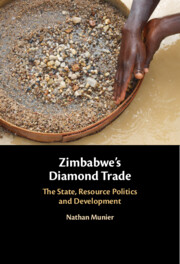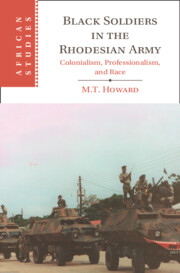Refine search
Actions for selected content:
176 results
6 - The Politics of Failure
- from Part II - Delivery
-
- Book:
- Charity After Empire
- Published online:
- 18 December 2025
- Print publication:
- 31 January 2026, pp 165-195
-
- Chapter
- Export citation
1 - Introduction
-
- Book:
- Death, Diversion, and Departure
- Published online:
- 19 December 2025
- Print publication:
- 22 January 2026, pp 1-32
-
- Chapter
- Export citation

Death, Diversion, and Departure
- Voter Exit and the Persistence of Authoritarianism in Zimbabwe
-
- Published online:
- 19 December 2025
- Print publication:
- 22 January 2026
When the cross-border remittance system fails: the impact of COVID-19 regulations on the food provision and access for cross-border migrant households in north-western Zimbabwe
-
- Journal:
- The Journal of Modern African Studies , First View
- Published online by Cambridge University Press:
- 15 December 2025, pp. 1-21
-
- Article
- Export citation
6 - Zimbabwe and Diamonds in the Southern African Region
-
- Book:
- Zimbabwe's Diamond Trade
- Published online:
- 06 November 2025
- Print publication:
- 04 December 2025, pp 110-140
-
- Chapter
- Export citation
1 - The Diamond Curse in Zimbabwe
-
- Book:
- Zimbabwe's Diamond Trade
- Published online:
- 06 November 2025
- Print publication:
- 04 December 2025, pp 1-22
-
- Chapter
- Export citation
3 - The Ownership Structure of Zimbabwe’s Diamond Sector
-
- Book:
- Zimbabwe's Diamond Trade
- Published online:
- 06 November 2025
- Print publication:
- 04 December 2025, pp 52-73
-
- Chapter
- Export citation
2 - Natural Resources and the State
-
- Book:
- Zimbabwe's Diamond Trade
- Published online:
- 06 November 2025
- Print publication:
- 04 December 2025, pp 23-51
-
- Chapter
- Export citation

Zimbabwe's Diamond Trade
- The State, Resource Politics and Development
-
- Published online:
- 06 November 2025
- Print publication:
- 04 December 2025
Stakeholder perceptions on the retrenchment laws in Zimbabwe
-
- Journal:
- The Economic and Labour Relations Review ,
- Published online by Cambridge University Press:
- 20 October 2025, pp. 1-18
-
- Article
-
- You have access
- Open access
- HTML
- Export citation
40 - Mother Tongue Education in Africa
- from Part VI - Minority Language Education
-
-
- Book:
- The Cambridge Handbook of Multilingual Education
- Published online:
- 25 December 2025
- Print publication:
- 14 August 2025, pp 774-787
-
- Chapter
- Export citation
Examining the effects of mental health literacy on stigma: study of Zimbabwe Prisons and Correctional Service (ZPCS)
-
- Journal:
- BJPsych International / Volume 22 / Issue 4 / November 2025
- Published online by Cambridge University Press:
- 21 May 2025, pp. 104-112
- Print publication:
- November 2025
-
- Article
-
- You have access
- Open access
- HTML
- Export citation
“Faith it, till you make it”: Prosperity Gospel and Spiritual Hustling among Young Pentecostal Christians in Harare
-
- Journal:
- African Studies Review / Volume 67 / Issue 4 / December 2024
- Published online by Cambridge University Press:
- 26 December 2024, pp. 941-966
-
- Article
-
- You have access
- Open access
- HTML
- Export citation
Prevalence of probable post-traumatic stress disorder and experiences of trauma in emerging adults living with HIV in Zimbabwe
-
- Journal:
- BJPsych Open / Volume 11 / Issue 1 / January 2025
- Published online by Cambridge University Press:
- 13 December 2024, e7
-
- Article
-
- You have access
- Open access
- HTML
- Export citation
Military Instrumentality in Rhodesia and Zimbabwe - Black Soldiers in the Rhodesian Army: Colonialism, Professionalism, and Race M. T. Howard. Cambridge: Cambridge University Press, 2024. Pp. xvi+282. $110.00, hardcover (ISBN: 9781009348447).
-
- Journal:
- The Journal of African History / Volume 65 / Issue 2 / July 2024
- Published online by Cambridge University Press:
- 20 November 2024, pp. 279-281
-
- Article
- Export citation
Neo-Imperial Cold War? Biafra's Franco-African Arms Triangle
-
- Journal:
- The Journal of African History / Volume 65 / Issue 1 / March 2024
- Published online by Cambridge University Press:
- 18 September 2024, pp. 47-65
-
- Article
-
- You have access
- Open access
- HTML
- Export citation
A situational and stakeholder analysis of health technology assessment in Zimbabwe
-
- Journal:
- International Journal of Technology Assessment in Health Care / Volume 40 / Issue 1 / 2024
- Published online by Cambridge University Press:
- 29 April 2024, e27
-
- Article
-
- You have access
- Open access
- HTML
- Export citation

Black Soldiers in the Rhodesian Army
- Colonialism, Professionalism, and Race
-
- Published online:
- 01 February 2024
- Print publication:
- 08 February 2024
Revisiting the Right in Zimbabwe of a Subrogated Insurer to Proceed against a Third Party in the Name of the Insured: Lessons from South Africa
-
- Journal:
- Journal of African Law / Volume 68 / Issue 1 / February 2024
- Published online by Cambridge University Press:
- 31 January 2024, pp. 109-123
- Print publication:
- February 2024
-
- Article
-
- You have access
- Open access
- HTML
- Export citation
16 - The 2030 Agenda, Climate Urbanism and Urban Planning in Zimbabwe
- from Part III - Sustainable Urban Planning in Africa
-
-
- Book:
- Reimagining Urban Planning in Africa
- Published online:
- 07 December 2023
- Print publication:
- 21 December 2023, pp 282-302
-
- Chapter
- Export citation
